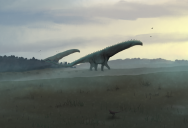The Largest Animal To Ever Walk The Earth Was 154,323 Pounds And 121 Feet Long

There’s nothing quite like visiting a zoo or wildlife sanctuary and standing next to an elephant or a giraffe, or seeing life-sized rendering of a blue whale, and realizing just how big they really are.
And honestly, those animals are nothing (as far as size) compared to the ones who walked this Earth millions of years ago.
The largest of the large, as far as land animals, is (as far as we know) the Patagotitan mayorum.
This animal weighed around 154,323 pounds, or roughly the same as 10 African elephants.
At 121 feet in length it was longer than a blue whale, but lighter and leaner.

The Patagotitan mayorum was a sauropod, a subgroup of dinosaurs characterized by long necks and tails, as well as four stocky legs that looked like pillars going into the ground.
Well known members of this group include the Brontosaurus and Diplodocus.
The Patagotitan mayorum roamed the Patagonia region of what is now southern Argentina. It was also home to the Argentinosaurus, which held the record of largest land animal before Patagotitan mayorum was discovered.
Since size estimate are just that, scientists are still wavering on which animal should actually wear this particular crown.
No complete specimens have been found, so until that day, the debate will likely continue.
Patagotitan mayorum fossils were first discovered in 2017, with the soil around them suggesting the animal lived around 100 million years ago.
They likely spend their time using their long necks to munch leaves from Cretaceous trees, and were probably not fearsome in anyways.
Giant cows, really, according to paleontologist Diego Pol of the Edigio Feruglio Paleontology Museum in Argentina.
“I don’t think they were scary at all. They were probably massive big slow-moving animals. Getting up. Walking around. Trying to run. It’s really challenging for large animals.”

That said, it’s size would put off most predators, so that’s something.
It’s possible there is another large species just out there in the ground, waiting to be discovered – one bigger even than this.
South American excavations are years behind those in the Northern Hemisphere, so anything is possible.
And if ask me, there’s something a little bit exciting about that.
If you thought that was interesting, you might like to read about the mysterious “pyramids” discovered in Antarctica. What are they?

Sign up to get our BEST stories of the week straight to your inbox.




